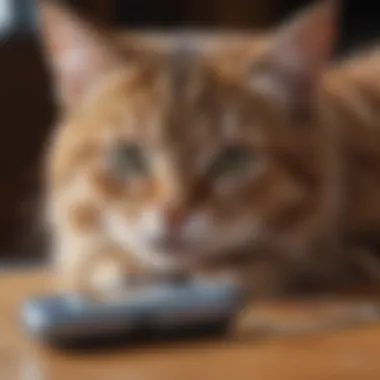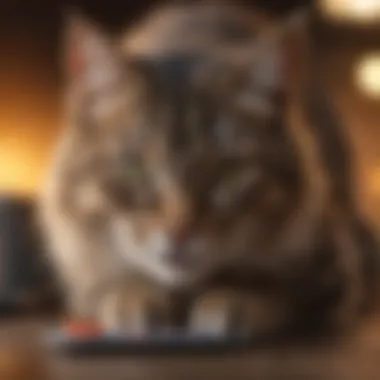Understanding Human Glucose Meters for Cats


Intro
Diabetes in cats is an increasingly prevalent health issue that requires attentive management. With the right tools, cat owners can ensure better glycemic control for their feline companions. One such tool gaining traction is the use of human glucose meters. This article explores the significance, effectiveness, and practical considerations of employing these devices in the context of feline diabetes management.
Understanding Feline Diabetes
Feline diabetes mellitus is a metabolic disorder characterized by high blood glucose levels. It primarily occurs due to insulin deficiency or resistance, making glucose monitoring critical for effective treatment. Cat owners often face challenges in maintaining their pet's glucose levels, leading to complications. Understanding how to use human glucose meters effectively can empower owners in monitoring their cat's health.
The Utility of Human Glucose Meters
Human glucose meters are commonly used in diabetes management for humans. These devices are capable of providing quick and accurate blood glucose readings. Many owners have begun to explore their use for cats due to the accessibility and cost-effectiveness of these devices.
- Ease of Use: Human glucose meters are user-friendly, making them a practical choice for home monitoring.
- Cost Effective: Compared to veterinary-specific devices, human meters are typically less expensive, thus accessible to a broader audience.
"Using human glucose meters can provide significant benefits in managing feline diabetes, allowing for timely interventions as needed."
Accuracy and Limitations
While human glucose meters offer several advantages, it is essential to recognize their limitations when applied to feline health.
Accuracy Issues
- Human meters may not account for the differences in feline physiology, potentially leading to discrepancies in glucose readings.
- Many meters measure glucose in plasma rather than whole blood, which can also affect accuracy.
Future Considerations
It is advised for cat owners to consult with veterinarians before relying solely on human devices for glucose monitoring. Regular vet check-ups can ensure that measurement methods are appropriate and effective.
Practical Monitoring Techniques
Using human glucose meters requires a bit of training and understanding.
- Familiarization: Owners must read the manual and understand how the device operates.
- Sample Collection: Learning the best sites for blood collection on your cat’s body is crucial. The ear pinna is often preferred.
- Calibrate Readings: Regularly compare readings from the human glucose meter to those obtained at the veterinarian's office to assess accuracy.
- Record Keeping: Maintain a log of your cat’s glucose levels, including time of day and any variables, like food intake or activity levels.
As cat owners embark on this journey of monitoring their cat's glucose levels at home, it is essential to remain patient and consistent. This approach not only enables owners to take control of their cat’s health but also fosters a deeper bond through shared responsibility.
Closure
The use of human glucose meters for cats presents an innovative approach to managing feline diabetes. While there are challenges related to accuracy and monitoring techniques, the potential benefits for pet owners cannot be overlooked. As the understanding of feline diabetes evolves, adapting human medical tools can be a practical step toward better management and improved health outcomes for cats with diabetes.
Foreword to Feline Diabetes
Feline diabetes is a significant health concern for many cat owners, revealing a pressing need for understanding and management strategies. This section introduces the concept of diabetes in cats, which is primarily characterized by insulin deficiency or insulin resistance. Such hormonal imbalances can lead to elevated blood glucose levels and various health complications if not addressed properly.
Managing diabetes in cats necessitates a comprehensive approach that includes dietary considerations, regular veterinary check-ups, and effective monitoring of blood glucose. As cat owners may already contend with the emotional burden of witnessing health issues in their pets, understanding feline diabetes is crucial. Knowledge empowers owners to make informed decisions about their cat’s care, potentially improving quality of life and prolonging longevity.
The significance of identifying diabetes early cannot be overstated. Timely intervention can not only mitigate severe health issues down the line but can also simplify the management of the disease itself. By establishing a strong foundation of knowledge about diabetes in cats, we can explore the tools available, including the role of human glucose meters in tracking blood sugar levels and their adaptation for feline needs.
Understanding Diabetes in Cats
Diabetes mellitus in cats can be broadly categorized into two types: Type 1 and Type 2. Type 1 is less common in cats but is characterized by a total lack of insulin production. Type 2, which is more prevalent, involves a relative deficiency of insulin often caused by insulin resistance. This can stem from factors like obesity, age, or other underlying conditions.
Observing how these forms manifest in felines is vital. Cats with diabetes often experience shifts in energy and behavior. Understanding these nuances enhances a pet owner’s ability to promptly recognize potential issues and thus seek veterinary assistance sooner rather than later.


Prevalence and Risk Factors in Domestic Cats
Diabetes is becoming increasingly common in domestic cats, with estimates suggesting a prevalence of around 1-2%. This underscores the importance of awareness amongst cat owners.
Several risk factors can heighten a cat's likelihood of developing diabetes. These include:
- Obesity: Excess weight is a primary risk factor, as it is linked to insulin resistance.
- Age: Older cats are at a greater risk because of the natural decline in metabolic processes.
- Lack of Activity: Sedentary lifestyles contribute to weight gain and metabolic issues.
- Gender: Male cats are statistically more likely to develop diabetes compared to females.
Understanding these elements can help propel preventive strategies among cat owners, enabling them to take proactive measures in their cat's healthcare regimen.
Signs and Symptoms of Diabetes Mellitus in Cats
Recognizing the signs and symptoms of diabetes mellitus in cats is key to effective management. Common indicators include:
- Increased thirst: Cats may drink more water as their body tries to compensate for high glucose levels.
- Frequent urination: This occurs as excess glucose is excreted through urine, leading to increased water intake.
- Weight loss: Despite a good appetite, cats may lose weight due to the body’s inability to utilize glucose effectively.
- Lethargy: A noticeable drop in energy levels can occur as the cat’s body's energy source becomes compromised.
By tracking such symptoms, owners can play an active role in detecting diabetes early. However, suspicion alone is not sufficient; a definitive diagnosis requires thorough veterinary evaluation. This sets the stage for utilizing monitoring tools such as human glucose meters, which will be discussed in further sections.
The Role of Glucose Monitoring
Monitoring glucose levels in cats plays a crucial role in managing diabetes. Regular tracking enables cat owners and veterinarians to make informed decisions about treatment options and dietary changes. With feline diabetes, accurate control of blood sugar levels is essential to prevent complications. High or low glucose levels can lead to serious health risks such as hypoglycemia and hyperglycemia, hence establishing a reliable monitoring system is vital.
Importance of Glycemic Control in Cats
Glycemic control refers to maintaining a cat's blood sugar levels within an optimal range. In diabetic cats, high blood sugar levels can cause various health issues, including neuropathy and kidney damage. Good control can significantly improve a cat's quality of life and longevity. Furthermore, optimal glycemic control reduces the likelihood of emergency veterinary visits, allowing for a more stable home environment for both the pet and the owner.
- Good glycemic control helps minimize the risk of secondary complications.
- It provides insights into the effectiveness of the treatment plan.
- Monitored blood sugar helps to adjust insulin doses appropriately, tailoring to the cat’s individual needs.
Advantages of Regular Monitoring
Regular glucose monitoring offers several advantages to cat owners. First, it allows for real-time tracking of a cat's response to treatment. If a glucose meter is used consistently, it becomes easier to recognize patterns and fluctuations in blood sugar levels. This consistency can lead to faster adjustments in lifestyle and dietary habits, improving the cat's overall health.
- Early Detection of Problems: Cat owners can detect abnormal levels before they lead to severe health consequences.
- Cost-Effective: It can reduce overall veterinary costs by minimizing potential emergency situations.
- Better Owner Awareness: Regular monitoring fosters a better understanding of diabetes management, educating owners on how lifestyle factors influence their cat’s health.
"Managing feline diabetes effectively through glucose monitoring can enhance not just a cat's health, but the owner’s peace of mind as well."
In summary, the role of glucose monitoring cannot be overstated. It is the backbone of effective diabetes management, providing insights that empower both pet owners and veterinarians.
Human Glucose Meters: An Overview
Monitoring blood glucose levels is a crucial aspect of managing diabetes in cats. Human glucose meters serve as an accessible tool for cat owners and veterinarians alike. This section delves into the significance of these devices, discussing their various types and functionalities.
With feline diabetes becoming a common health issue among domestic cats, these meters present a practical solution for tracking blood glucose levels without needing specialized veterinary equipment. They allow for real-time monitoring, which can lead to timely interventions and more effective management of the health condition.
Moreover, human glucose meters can provide significant cost savings over traditional veterinary glucose monitoring methods. Though they may have some limitations, understanding their proper usage is essential for optimizing feline health outcomes.
Types of Human Glucose Meters
Human glucose meters are designed in several different ways, each with unique benefits. Here are the primary types you will encounter:
- Traditional Meters: These require a blood sample to be placed on a test strip. The meter reads the glucose level and displays it on-screen. This type is widely used due to its accuracy and relative simplicity.
- Continuous Glucose Monitors (CGMs): These devices involve inserting a tiny sensor under the skin, which continuously measures glucose levels. While they provide dynamic data over time, the cost may be higher compared to traditional meters.
- Smartphone-Integrated Glucose Meters: Some newer models connect to smartphones via Bluetooth, allowing users to log and track readings through an application. This feature can be particularly beneficial for those who prefer to have all their health information consolidated.
Each type offers varying degrees of convenience and technological advancement. The choice may depend on personal preferences, budget, and specific monitoring needs for the cat.


How Human Glucose Meters Work
Understanding how human glucose meters function is key for effective usage in feline diabetes management. The general process involves the following steps:
- Sample Collection: A small blood sample is obtained, usually from the ear or paw of the cat. It is crucial to prepare the cat properly to minimize stress during this process.
- Applying to Test Strip: The blood sample is placed on a test strip, which is inserted into the meter. The test strip contains enzymes that react with glucose, producing an electrical signal proportional to the glucose amount.
- Reading Measurement: After a brief waiting period, which is often just seconds, the meter's display shows the blood glucose level. This reading can help determine if the cat's glucose levels are within the target range.
- Data Logging: Some meters keep track of previous results, making it easier for owners and veterinarians to monitor trends over time.
If accurately monitored, human glucose meters can facilitate better glycemic control and enable owners to make informed decisions regarding their cat's dietary and insulin needs. However, optimal outcomes can only be achieved if the meters are used with a solid understanding of their limitations and specific application to feline health.
Using Human Glucose Meters for Cats
Using human glucose meters for cats presents a practical approach to managing feline diabetes. This option allows owners to keep an eye on their cat's blood sugar levels closely, which is crucial for ensuring effective glycemic control. The convenience of such meters, combined with their affordability, often makes them an attractive choice, especially for cat owners who are well versed in monitoring their pets' health. Moreover, understanding how these devices can be adapted for feline use empowers caregivers to take an active role in their pets' health management.
Adaptation for Feline Use
Adapting human glucose meters for cats typically involves some modifications in technique. Since feline blood glucose levels can differ from those of humans, it is essential to choose the right device and familiarize oneself with its operation specific to feline physiology. Areas such as the ear edge or paw pads can serve as suitable sites for blood sample collection. Additionally, using specialized lancets designed for cats can reduce discomfort during the blood draw process.
Best Practices for Accurate Measurement
To enhance accuracy in glucose readings, several best practices should be followed. Firstly, ensure that the meter is correctly calibrated as per the manufacturer's instructions. Secondly, the blood sample should be adequate in size, as insufficient samples often yield erroneous readings. It is also advisable to perform tests at consistent times, ideally before feeding or insulin administration, to maintain a standardized environment. Keeping detailed records of the readings can also help in identifying patterns or fluctuations in glucose levels over time, which is vital for prompt intervention if needed.
Potential Challenges and Limitations
Despite the benefits, challenges and limitations exist in using human glucose meters for cats. One primary concern is that certain human meters may not be tailored for the unique hemoglobin characteristics of cats. This can lead to inaccuracies in blood glucose readings, potentially misguiding treatment decisions. Additionally, stress during measurement can influence glucose levels, especially if the cat is not acclimated to the process. It is also necessary to keep in mind that human meters might lack certain features and functionalities that veterinary-specific devices may offer. Overall, pet owners should weigh the pros and cons carefully before relying solely on human glucose meters.
Comparative Analysis with Veterinary Glucose Meters
The discussion of human glucose meters in the context of feline diabetes management necessitates a comparison with veterinary glucose meters. This comparison highlights critical aspects such as device differences, functionality, and implications for monitoring cat health. Understanding these elements is essential for pet owners and veterinarians alike, as it enables informed decisions regarding the most suitable monitoring devices for diabetic cats.
Differences Between Human and Veterinary Devices
Human glucose meters are designed explicitly for human physiology and may not always consider the unique physiology of cats. Their scale and design are tailored for human fingers, which can create challenges when attempting to obtain blood samples from cats. Additionally, the ranges of blood glucose readings may differ.
Veterinary glucose meters are specifically engineered for animals. They typically accommodate the nuances of feline blood samples. For instance:
- Cartridge Size: The sample volumes required by veterinary devices tend to be smaller, making them more practical for use on cats.
- Measurement Units: Some veterinary meters use different measurement units, which can lead to confusion if one switches between human and veterinary devices.
- Functionality Features: Veterinary devices often include predefined settings based on species, allowing for tailored assessments.
Pet owners should assess their needs before opting for a glucose meter. It is crucial to understand the device they choose will serve their pet's unique monitoring requirements.
Accuracy Considerations
Accuracy is paramount in managing feline diabetes. Both types of glucose meters claim to provide reliable readings, yet discrepancies can arise due to various factors.
- Calibration Differences: Human glucose meters are calibrated for human blood, which means they might not provide precise readings for cats. This can lead to incorrect insulin dosage decisions when relying on human meters.
- Environmental Influence: Factors like temperature, humidity, and even altitude can affect readings. Veterinary meters may be equipped to compensate for such variations, while human meters could be less robust in handling these environmental nuances.
- User Technique: Skills in blood sample collection play a crucial role. Cat owners must be trained properly to obtain accurate results. Incorrect sampling can lead to false readings, regardless of the meter type.
Accurate glucose monitoring is essential for diabetes management. Using the appropriate device ensures timely and correct treatment.
Alternatives to Human Glucose Meters
When managing feline diabetes, considering alternatives to human glucose meters is essential. While some cat owners successfully use these devices, they are not always the best fit due to specific feline needs and behaviors. Understanding other available options assists in making informed decisions that can significantly impact the health and well-being of diabetic cats. This section explores veterinary-specific options and continuous glucose monitoring systems, evaluating their advantages and potential pitfalls.
Veterinary-Specific Options
Veterinary-specific glucose meters are designed with the unique needs of cats in mind. These devices take into account the distinct physiological differences between humans and felines. Many veterinary glucose meters provide tailored features, such as using smaller blood samples, which is beneficial given that cats often resist prolonged or invasive procedures. Additionally, these meters frequently come equipped with user-friendly displays that make it easier to interpret results quickly.


Some notable benefits of veterinary-specific glucose meters include:
- Accuracy: These meters are calibrated specifically for feline blood, increasing reliability for monitoring glucose levels.
- Ease of Use: They typically have design elements that facilitate easier operation for cat owners, including larger buttons and simplified startup procedures.
- Comprehensive Data: Some models offer advanced data tracking capabilities, allowing owners to monitor trends over time.
In choosing a veterinary-specific glucose meter, it is advisable to consult with a veterinarian. Individual cats may have unique needs, and professional advice can guide the selection process toward the best option.
Continuous Glucose Monitoring Systems
Continuous glucose monitoring systems represent a more advanced technology for monitoring blood glucose. These devices provide real-time data by measuring glucose levels at regular intervals, making it possible to detect fluctuations as they occur. This capability can help cat owners ensure that their pets are within a healthy glycemic range throughout the day.
The advantages of continuous glucose monitoring systems include:
- Real-Time Readings: Provides immediate feedback, helping owners respond timely to significant level changes.
- Data Aggregation: This technology often compiles data over time, helping veterinarians analyze trends more effectively than traditional tests.
- Enhanced Health Management: Allows for adjustments to diet and insulin dosing based on detailed monitoring, improving overall diabetes care.
However, these systems come with considerations. They may require more initial investment and learning to operate them effectively. Cat owners could find some alert functions distracting if the cat is active or running around.
Practical Guide for Cat Owners
Understanding how to monitor your cat’s blood glucose effectively is crucial, especially for those managing feline diabetes. This guide offers practical strategies, helping pet owners develop a structured approach to glucose monitoring, ensuring the health of their beloved cats.
Establishing a Monitoring Routine
Creating a consistent monitoring routine is essential for maintaining glycemic control in diabetic cats. This process begins with setting up a schedule that aligns with your cat’s feeding and medication times. A well-structured routine leads to more reliable data on your cat's blood sugar levels.
- Frequency: Ideally, blood glucose should be checked at least twice a day. This frequency allows for insights into fluctuations and trends.
- Method: Choose a time of day that allows for stable conditions, preferably when your cat is calm. Also, ensure that you are equipped with a reliable human glucose meter, such as the OneTouch Ultra or Accu-Chek, to facilitate quick and efficient readings.
- Record Keeping: Maintain a detailed log of each measurement, noting the time, reading, and any relevant observations regarding your cat's behavior or diet. This data becomes invaluable over time, enabling you to spot patterns.
Interpreting Blood Glucose Readings
Knowing how to interpret blood glucose readings is vital. Feline blood glucose levels typically range from 70 to 150 mg/dL. Understanding what these numbers mean can help in adjusting your cat's diet or medication as required.
- Low Readings (Hypoglycemia): If you obtain a reading below 70 mg/dL, it is essential to act quickly. This level can lead to severe complications. Administer a small amount of corn syrup or honey, and contact your veterinarian immediately for further guidance.
- Normal Readings: Readings between 70 and 150 mg/dL indicate that glycemic control is generally acceptable. However, regular monitoring helps avoid spikes or drops that could signal underlying issues.
- High Readings (Hyperglycemia): Levels above 150 mg/dL may indicate insufficient insulin, stress, or dietary indiscretion. Taking an immediate note of such readings and consulting your vet can lead to timely interventions.
When to Seek Veterinary Advice
Knowing when to consult a veterinarian is just as crucial as monitoring glucose levels. If your cat exhibits any signs of distress or unusual behavior, immediate professional advice is essential. Key indicators that warrant a visit include:
- Persistently High Glucose Levels: If multiple readings over the course of a few days consistently exceed 150 mg/dL, it’s time to consult your veterinarian.
- Signs of Hypoglycemia: If your cat shows weakness, confusion, or seizures, seek immediate veterinary attention.
- Behavioral Changes: Sudden changes in appetite, energy level, or bathroom habits can be significant indicators that something is amiss.
Monitoring blood glucose in diabetic cats serves as a powerful tool for ensuring their health. A diligent routine paired with proper interpretation and proactive veterinary communication fosters better outcomes for your feline companion.
Implement these strategies to navigate the complexities of feline diabetes with confidence.
The End
The conclusion of this article is pivotal as it encapsulates the critical aspects of using human glucose meters for monitoring feline diabetes. As discussed throughout the sections, glucose monitoring is essential for managing diabetes effectively in cats. It provides a pathway to understanding their glycemic levels, which is vital for maintaining their overall health and well-being.
The Future of Feline Diabetes Management
Looking ahead, the future of managing feline diabetes is likely to incorporate advanced technology. Innovations in both human and veterinary fields may lead to more tailored glucose monitoring solutions for cats. For example, developments in mobile applications could provide real-time data tracking. Further, artificial intelligence might play a role in analyzing glucose patterns, ultimately assisting veterinarians to make personalized treatment plans more efficient.
The continuous emphasis on research will be key in enhancing the understanding of feline diabetes management. As more data becomes available, it will inform the creation of better treatment protocols and health guidelines for cats. Collaboration between veterinarians, pet owners, and technology developers will become increasingly significant in shaping this future. Ensuring cats with diabetes receive optimal care requires a multifaceted approach that combines modern technology, owner education, and ongoing veterinary support.
Final Thoughts on Human Glucose Meters for Cats
In summation, the use of human glucose meters for cats poses both opportunities and challenges. While these devices are accessible and can offer immediate insights into a cat's health, it is crucial to understand their limitations. Regular monitoring can empower pet owners but should be complemented with guidance from a veterinarian.
"Healthcare for pets relies on accurate data and the collaboration between owners and professionals to ensure the best outcomes."
The comfort of our feline companions greatly hinges on effective diabetes management. By utilizing human glucose meters prudently, pet owners can contribute significantly to their cats' health. Ultimately, the success of these tools lies in education and careful application, fostering better health outcomes for our cherished pets.







